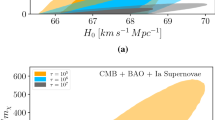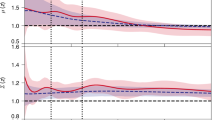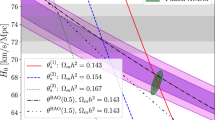Abstract
A flat Friedmann–Robertson–Walker universe dominated by a cosmological constant (Λ) and cold dark matter (CDM) has been the working model preferred by cosmologists since the discovery of cosmic acceleration1,2. However, tensions of various degrees of significance are known to be present among existing datasets within the ΛCDM framework3,4,5,6,7,8,9,10,11. In particular, the Lyman-α forest measurement of the baryon acoustic oscillations (BAO) by the Baryon Oscillation Spectroscopic Survey3 prefers a smaller value of the matter density fraction Ω M than that preferred by cosmic microwave background (CMB). Also, the recently measured value of the Hubble constant, H 0 = 73.24 ± 1.74 km s−1 Mpc−1 (ref. 12), is 3.4σ higher than the 66.93 ± 0.62 km s−1 Mpc−1 inferred from the Planck CMB data7. In this work, we investigate whether these tensions can be interpreted as evidence for a non-constant dynamical dark energy. Using the Kullback–Leibler divergence13 to quantify the tension between datasets, we find that the tensions are relieved by an evolving dark energy, with the dynamical dark energy model preferred at a 3.5σ significance level based on the improvement in the fit alone. While, at present, the Bayesian evidence for the dynamical dark energy is insufficient to favour it over ΛCDM, we show that, if the current best-fit dark energy happened to be the true model, it would be decisively detected by the upcoming Dark Energy Spectroscopic Instrument survey14.
This is a preview of subscription content, access via your institution
Access options
Access Nature and 54 other Nature Portfolio journals
Get Nature+, our best-value online-access subscription
$29.99 / 30 days
cancel any time
Subscribe to this journal
Receive 12 digital issues and online access to articles
$119.00 per year
only $9.92 per issue
Buy this article
- Purchase on Springer Link
- Instant access to full article PDF
Prices may be subject to local taxes which are calculated during checkout



Similar content being viewed by others
References
Riess, A. G. et al. Observational evidence from supernovae for an accelerating universe and a cosmological constant. Astron. J. 116, 1009–1038 (1998).
Perlmutter, S. et al. Measurements of Ω and Λ from 42 high-redshift supernovae. Astrophys. J. 517, 565–586 (1999).
Delubac, T. et al. Baryon acoustic oscillations in the Lyα forest of BOSS DR11 quasars. Astron. Astrophys. 574, A59 (2015).
Sahni, V., Shafieloo, A. & Starobinsky, A. A. Model-independent evidence for dark energy evolution from baryon acoustic oscillations. Astrophys. J. Lett. 793, L40 (2014).
Battye, R. A., Charnock, T. & Moss, A. Tension between the power spectrum of density perturbations measured on large and small scales. Phys. Rev. D 91, 103508 (2015).
Aubourg, É. et al. Cosmological implications of baryon acoustic oscillation measurements. Phys. Rev. D 92, 123516 (2015).
Planck Collaboration et al. Planck 2015 results. XIII. Cosmological parameters. Astron. Astrophys. 594, A13 (2016).
Raveri, M. Are cosmological data sets consistent with each other within the Λ cold dark matter model? Phys. Rev. D 93, 043522 (2016).
Addison, G. E. et al. Quantifying discordance in the 2015 Planck CMB spectrum. Astrophys. J. 818, 132 (2016).
Bernal, J. L., Verde, L. & Riess, A. G. The trouble with H 0. J. Cosmol. Astropart. Phys. 10, 019 (2016).
Freedman, W. L. Cosmology at a crossroads. Nat. Astron. 1, 0121 (2017).
Riess, A. G. et al. A 2.4% determination of the local value of the Hubble constant. Astrophys. J. 826, 56 (2016).
Kullback, S. & Leibler, R. A. On information and sufficiency. Ann. Math. Stat. 22, 79 (1951).
DESI Collaboration et al. The DESI experiment part I: science, targeting, and survey design. Preprint at https://arxiv.org/abs/1611.00036 (2016).
Seehars, S., Amara, A., Refregier, A., Paranjape, A. & Akeret, J. Information gains from cosmic microwave background experiments. Phys. Rev. D 90, 023533 (2014).
Linder, E. V. Exploring the expansion history of the Universe. Phys. Rev. Lett. 90, 091301 (2003).
Crittenden, R. G., Zhao, G.-B., Pogosian, L., Samushia, L. & Zhang, X. Fables of reconstruction: controlling bias in the dark energy equation of state. J. Cosmol. Astropart. Phys. 2, 048 (2012).
Vikman, A. Can dark energy evolve to the phantom? Phys. Rev. D 71, 023515 (2005).
Feng, B., Wang, X. & Zhang, X. Dark energy constraints from the cosmic age and supernova. Phys. Lett. B 607, 35–41 (2005).
Das, S., Corasaniti, P. S. & Khoury, J. Superacceleration as the signature of a dark sector interaction. Phys. Rev. D 73, 083509 (2006).
Zhao, G.-B., Crittenden, R. G., Pogosian, L. & Zhang, X. Examining the evidence for dynamical dark energy. Phys. Rev. Lett. 109, 171301 (2012).
Reid, B. A. et al. The clustering of galaxies in the SDSS-III Baryon Oscillation Spectroscopic Survey: measurements of the growth of structure and expansion rate at z=0.57 from anisotropic clustering. Mon. Not. R. Astron. Soc. 426, 2719–2737 (2012).
Zhao, G.-B. et al. The clustering of galaxies in the completed SDSS-III Baryon Oscillation Spectroscopic Survey: tomographic BAO analysis of DR12 combined sample in Fourier space. Mon. Not. R. Astron. Soc. 466, 762–779 (2017).
Riess, A. G. et al. A redetermination of the Hubble constant with the Hubble Space Telescope from a differential distance ladder. Astrophys. J. 699, 539–563 (2009).
Larson, D. et al. Seven-year Wilkinson Microwave Anisotropy Probe (WMAP) observations: power spectra and WMAP-derived parameters. Astrophys. J. Suppl. 192, 16 (2011).
Astier, P., Guy, J., Pain, R. & Balland, C. Dark energy constraints from a space-based supernova survey. Astron. Astrophys. 525, A7 (2011).
Di Valentino, E., Melchiorri, A. & Silk, J. Reconciling Planck with the local value of H 0 in extended parameter space. Phys. Lett. B 761, 242–246 (2016).
Solà, J., Gómez-Valent, A. & de Cruz Pérez, J. First evidence of running cosmic vacuum: challenging the concordance model. Astrophys. J. 836, 43 (2017).
Wang, Y., Zhao, G.-B., Wands, D., Pogosian, L. & Crittenden, R. G. Reconstruction of the dark matter–vacuum energy interaction. Phys. Rev. D 92, 103005 (2015).
Bautista, J. E. et al. Measurement of BAO correlations at z=2.3 with SDSS DR12 Lyα-forests. Preprint at https://arxiv.org/abs/1702.00176 (2017).
Grandis, S., Seehars, S., Refregier, A., Amara, A. & Nicola, A. Information gains from cosmological probes. J. Cosmol. Astropart. Phys. 5, 034 (2016).
Seehars, S., Grandis, S., Amara, A. & Refregier, A. Quantifying concordance in cosmology. Phys. Rev. D 93, 103507 (2016).
Raveri, M., Martinelli, M., Zhao, G. & Wang, Y. Information gain in cosmology: from the discovery of expansion to future surveys. Preprint at https://arxiv.org/abs/1606.06273 (2016).
Paykari, P. & Jaffe, A. H. Sparsely sampling the sky: a Bayesian experimental design approach. Mon. Not. R. Astron. Soc. 433, 3523–3533 (2013).
Kunz, M., Trotta, R. & Parkinson, D. R. Measuring the effective complexity of cosmological models. Phys. Rev. D 74, 023503 (2006).
Amara, A. & Refregier, A. Model breaking measure for cosmological surveys. Phys. Rev. D 89, 083501 (2014).
Verde, L., Protopapas, P. & Jimenez, R. The expansion rate of the intermediate universe in light of Planck. Phys. Dark Univ. 5, 307–314 (2014).
Charnock, T., Battye, R. A. & Moss, A. Planck confronts large scale structure: methods to quantify discordance. Preprint at https://arxiv.org/abs/1703.05959 (2017).
Betoule, M. et al. Improved cosmological constraints from a joint analysis of the SDSS-II and SNLS supernova samples. Astron. Astrophys. 568, A22 (2014).
Beutler, F. et al. The 6dF Galaxy Survey: baryon acoustic oscillations and the local Hubble constant. Mon. Not. R. Astron. Soc. 416, 3017–3032 (2011).
Ross, A. J. et al. The clustering of the SDSS DR7 main galaxy sample - I. A 4 per cent distance measure at z=0.15. Mon. Not. R. Astron. Soc. 449, 835–847 (2015).
Parkinson, D. et al. The WiggleZ Dark Energy Survey: final data release and cosmological results. Phys. Rev. D 86, 103518 (2012).
Heymans, C. et al. CFHTLenS tomographic weak lensing cosmological parameter constraints: mitigating the impact of intrinsic galaxy alignments. Mon. Not. R. Astron. Soc 432, 2433–2453 (2013).
Moresco, M. et al. A 6% measurement of the Hubble parameter at z∼0.45: direct evidence of the epoch of cosmic re-acceleration. J. Cosmol. Astropart. Phys. 5, 014 (2016).
Alam, S. et al. The clustering of galaxies in the completed SDSS-III Baryon Oscillation Spectroscopic Survey: cosmological analysis of the DR12 galaxy sample. Preprint at https://arxiv.org/abs/1607.03155 (2016).
Dalal, N., Pen, U.-L. & Seljak, U. Large-scale BAO signatures of the smallest galaxies. J. Cosmol. Astropart. Phys. 11, 007 (2010).
Beutler, F., Seljak, U. & Vlah, Z. Constraining the relative velocity effect using the Baryon Oscillation Spectroscopic Survey. Preprint at https://arxiv.org/abs/1612.04720 (2016).
Slepian, Z. et al. Constraining the baryon–dark matter relative velocity with the large-scale 3-point correlation function of the SDSS BOSS DR12 CMASS galaxies. Preprint at https://arxiv.org/abs/1607.06098 (2016).
Ma, C., Corasaniti, P.-S. & Bassett, B. A. Application of Bayesian graphs to SN Ia data analysis and compression. Mon. Not. R. Astron. Soc. 463, 1651–1665 (2016).
Shafieloo, A., Clifton, T. & Ferreira, P. The crossing statistic: dealing with unknown errors in the dispersion of type Ia supernovae. J. Cosmol. Astropart. Phys. 8, 017 (2011).
Crittenden, R. G., Pogosian, L. & Zhao, G.-B. Investigating dark energy experiments with principal components. J. Cosmol. Astropart. Phys. 12, 025 (2009).
Lewis, A., Challinor, A. & Lasenby, A. Efficient computation of cosmic microwave background anisotropies in closed Friedmann–Robertson–Walker models. Astrophys. J. 538, 473–476 (2000).
Zhao, G.-B., Xia, J.-Q., Li, M., Feng, B. & Zhang, X. Perturbations of the Quintom models of dark energy and the effects on observations. Phys. Rev. D 72, 123515 (2005).
Handley, W. J., Hobson, M. P. & Lasenby, A. N. POLYCHORD: nested sampling for cosmology. Mon. Not. R. Astron. Soc. 450, L61–L65 (2015).
Lewis, A. & Bridle, S. Cosmological parameters from CMB and other data: a Monte Carlo approach. Phys. Rev. D 66, 103511 (2002).
Huterer, D. & Starkman, G. Parametrization of dark energy properties: a principal component approach. Phys. Rev. Lett. 90, 031301 (2003).
Acknowledgements
G.-B.Z. is supported by National Natural Science Foundation of China (NSFC) Grant No. 11673025, and by a Royal Society-Newton Advanced Fellowship. G.-B.Z. and Y.W. are supported by National Astronomical Observatories, Chinese Academy of Sciences, and by University of Portsmouth. M.R. is supported by US Department of Energy contract DE-FG02-13ER41958. M.R. acknowledges partial support, during the development of this work, by the Italian Space Agency (ASI) through the ASI contracts Euclid-IC (I/031/10/0) and the INFN-INDARK initiative. M.R. thanks Scuola Internazionale Superiore di Studi Avanzati, where part of this work was completed. L.P. is supported by The Natural Sciences and Engineering Research Council of Canada, R.C. by Science and Technology Facilities Council grant ST/H002774/1, and Y.W. by NSFC Grant No. 11403034. G.R. acknowledges support from the National Research Foundation of Korea (NRF) through NRF-SGER 2014055950 funded by the Korean Ministry of Education, Science and Technology (MoEST), and from the faculty research fund of Sejong University in 2016. A.S. would like to acknowledge the support of the National Research Foundation of Korea (NRF - 2016R1C1B2016478). Funding for SDSS-III has been provided by the Alfred P. Sloan Foundation, the Participating Institutions, the National Science Foundation and the US Department of Energy Office of Science. The SDSS-III website is http://www.sdss3.org/. SDSS-III is managed by the Astrophysical Research Consortium for the Participating Institutions of the SDSS-III Collaboration including the University of Arizona, the Brazilian Participation Group, Brookhaven National Laboratory, Carnegie Mellon University, University of Florida, the French Participation Group, the German Participation Group, Harvard University, the Instituto de Astrosica de Canarias, the Michigan State/Notre Dame/JINA Participation Group, Johns Hopkins University, Lawrence Berkeley National Laboratory, Max Planck Institute for Astrophysics, Max Planck Institute for Extraterrestrial Physics, New Mexico State University, New York University, Ohio State University, Pennsylvania State University, University of Portsmouth, Princeton University, the Spanish Participation Group, University of Tokyo, University of Utah, Vanderbilt University, University of Virginia, University of Washington and Yale University.
Author information
Authors and Affiliations
Contributions
G.-B.Z. proposed the idea, performed the dark energy reconstruction, evidence calculation, principal-component analysis and tension calculation. M.R. and Y.W. contributed to the tension calculation. G.-B.Z. and L.P. wrote the draft, and all other co-authors commented on and helped to improve the manuscript and/or contributed to the BOSS data analysis.
Corresponding author
Ethics declarations
Competing interests
The authors declare no competing financial interests.
Additional information
Publisher’s note: Springer Nature remains neutral with regard to jurisdictional claims in published maps and institutional affiliations.
Electronic supplementary material
Supplementary Information
Supplementary Tables 1–3, Supplementary Figures 1–5 and Supplementary References
Rights and permissions
About this article
Cite this article
Zhao, GB., Raveri, M., Pogosian, L. et al. Dynamical dark energy in light of the latest observations. Nat Astron 1, 627–632 (2017). https://doi.org/10.1038/s41550-017-0216-z
Received:
Accepted:
Published:
Issue Date:
DOI: https://doi.org/10.1038/s41550-017-0216-z
This article is cited by
-
A model of dark matter–dark energy interaction with some cosmic consequences
Indian Journal of Physics (2023)
-
Intensity mapping of post-reionization 21-cm signal and its cross-correlations as a probe of f(R) gravity
Journal of Astrophysics and Astronomy (2023)
-
Stepped partially acoustic dark matter, large scale structure, and the Hubble tension
Journal of High Energy Physics (2023)
-
Nested sampling for physical scientists
Nature Reviews Methods Primers (2022)
-
Bianchi type-I viscous fluid and interacting dark energy cosmological model in general relativity
Pramana (2022)



